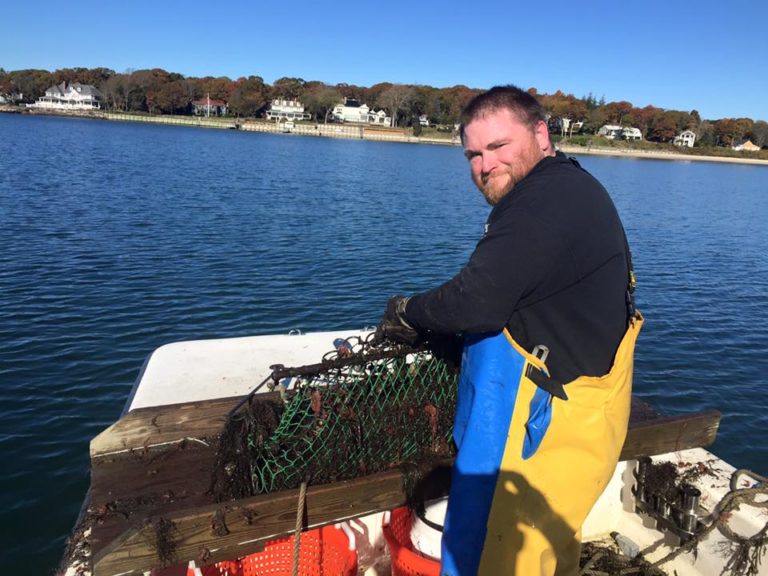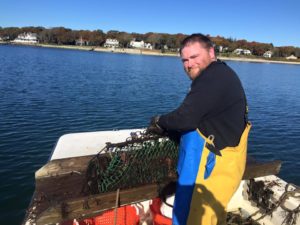
In the following interview, Waterkeeper Alliance Organizer Malaika Elias speaks with Peconic Baykeeper Sean O’Neill to discuss the adverse effects of climate change on the Peconic Bay. Sean walks us through climate impacts on marine life and communities, and suggests actions we can all take to address the pervasive and escalating implications that accompany the climate and water nexus.
Malaika Elias: Broadly speaking, what’s the big issue with climate change and how are Waterkeepers working to address the problem?
Sean O’Neill: Climate change is certainly happening and there is a lot of time and effort spent on debating whether the science is true or not. Much like many other coastal cities, it is becoming a very clear and present danger to our communities in New York. On our side of the movement, of course it’s true, but rather than have that debate I think it’s more important to look at what we can do.
What we are slowly moving towards is the idea of coastal adaptation opposed to coastal restoration. We are adapting to climate change rather than trying to employ the same old methods and hope they work. As Waterkeepers, we don’t have the overall ability to change the infrastructure of our energy economy, however, we can change the discussion of the policy around how we’re going to deal with the actual implications from climate change we are seeing in our watershed.
ME: Can you give us some specific examples of how climate change is impacting Peconic Bay? What effects does it have on erosion and flooding?
SO: In the Peconic Estuary some of the biggest changes that we’re seeing are erosion of beaches and flooding of coastal communities. We currently have an Army Corps of Engineers project going on all along the south shore of Long Island called the Fire Island to Montauk Point (FIMP) project. It’s a $1.2 billion project which basically entails pushing sand around and reflects these traditional responses to climate change like building a bigger dune if we have flooding or building a bigger berm and hoping that works. Clearly, these solutions aren’t effective as sea level rise increases and flooding happens more frequently. These, at best, are temporary stop-gap solutions.
As we spend billions of dollars on projects like FIMP to harden our shorelines, all we’re doing is buying little bits of time. What we would like to see and what we advocate for are solutions which build natural defenses to climate change. For instance, working to rebuild salt marshes and creating or maintaining breaches in our barrier beaches so that salt marsh can naturally form behind it and act as a flood barrier to our coastal communities.
ME: How does climate change impact marine life in Peconic Bay?
SO: Another big issue in Peconic Bay in particular is the temperature-induced migration of different fish species. One of the best databases we have to work with comes from the New York State Department of Environmental Conservation which does a yearly trawl survey where they go out and trawl and take an index of the different finfish they find in the bay. They have witnessed and recorded very clear trends where warm water species that used to be at the north of their range here, for instance Black Sea Bass, are becoming dominant in the Peconic Estuary. On the other hand, cold water species like the Winter Flounder are disappearing from the estuary.
As our estuary warms, its composition is changing. We’re seeing less and less Eelgrass for a variety of reasons, one of which is simply temperature. What used to be the nursery for fishes in the Peconic Estuary is slowly going away. We can continue with what has been done historically restoration wise by planting more Eelgrass and trying to replenish what used to be there or we can adapt to what actually exists now and try to protect it moving forward.
ME: Are there any other serious impacts of climate change evident in Peconic Bay?
SO: Ocean acidification, of course, is another climate threat impacting our watershed. Just recently, I happened to be at a meeting with some people from Molloy College on Long Island who are running a horseshoe crab lab. The Horseshoe crab is a very important invertebrate that’s been around since prehistoric times, and it breeds in the Peconic Estuary. The lab’s research is focusing on pH changes, basically due to ocean acidification and survivability of these young horseshoe crabs.
Another species impacted by ocean acidification is the Summer Flounder, a vital species for commercial and recreational purposes which exists offshore of Long Island. We’re seeing dramatic effects on its ability to breed based on very slight changes in ocean pH levels. Even though we’re contributing our best efforts to manage the species for abundance and telling commercial and recreational interests to take less and less every year, this method might not be as effective as we’d like it to be simply because the pH is changing and they are not able to breed as successfully as they used to. We’re seeing real effects on our species and it is important that we continue to recognize that these changes are clearly linked to human inputs from carbon, sulfur, nitrogen, etc. As a result, we need to implement better practices to ensure those species are going to be around for a while.
ME: How are local communities particularly affected by climate change?
SO: Something that hasn’t been discussed extensively but is becoming more and more important is — coastal retreat. Two very good examples of communities dealing with coastal flooding include Mastic on the south shore of Long Island and Montauk Point, which is on the end of our jurisdiction. Both areas are experiencing constant flooding due to sea level rise and it’s not just an occasional occurrence — it’s an everyday thing. Various solutions and attempts to try to mitigate this —whether it’s putting sandbags on the beach or trying to build up berms — are not working and the towns are going under water. So it’s the first time we’re hearing people talk about coastal retreat and literally buying up properties or the government using up funds to buy properties that are habitually flooded and moving people inland. I think that’s probably the starkest example of what could happen, and what is going to happen as sea level rises with warming ocean waters. We are literally going to have to start moving people away from the ocean.
The reason I use Mastic and Montauk as examples is because they’re very different communities. The people on the oceanfront in Montauk are generally affluent; whether they’re people or businesses, they’re generally well off. Alternately, Mastic is one of the least affluent places on Long Island and there’s a lot of poverty and bad planning as the community was basically built in the salt marshes of the bay. So it’s not something that only impacts one type of community. I think a lot of people have the misconception that ocean retreat is just a rich people problem and it’s not — it’s an everyday problem impacting a multitude of communities regardless of their socioeconomic status. It’s important to consider how funds are allocated for coastal retreat. Who gets it first? The person that can probably afford to pay for it anyway or the person who can’t really afford to pay for it? This is where the intersection of all types of social justice issues become incredibly evident and unavoidable.
ME: What is the one call to action you would suggest for someone who wants to get involved in resilience efforts on Long Island or New York in general?
SO: I think it’s a matter of getting in touch with local environmental organizations, whether it’s us (Peconic Baykeeper) or others like Friends of Bellport Bay and Moriches Bay Project; there are several small community-based organizations on Long Island to choose from. These groups along with Peconic Baykeeper are reliable sources of information if you just want to be more aware and knowledgeable about the issues and where you can show up to community forums, legislative hearings, and where to engage.
Any time policy changes — whether it’s regarding beach erosion or dealing with flooding — it has to be voted on and every time it’s voted on there have to be legislative hearings. I think that’s where the laymen can have their voices heard and make the most effort. Letter writing campaigns and that level of advocacy is also important, in addition to getting in touch with your local environmental organizations and engaging in on the ground work. Using a combination of these strategies gives you your best chance of getting involved. Your local environmental organizations are the ones running those kinds of programs, and if they aren’t they can put you in touch with the people that are doing that type of work.
Climate change is happening and we’re feeling its effects ubiquitously. Even if we shut off every car or power plant in the world right now we’d still be dealing with these issues so I think it’s important, now more than ever, to shift our focus to creative solutions and learn what science and technology can offer and understand how are we going to deal with what’s happening. It’s bad, I agree. It’s wrong, I agree, but that doesn’t really matter. What really matters is what are we going to do about it and how we move forward.
 Sean has been the Peconic Baykeeper since April 2016, and Executive Director since April 2017. Peconic Baykeeper’s clean water mission focuses on establishing and maintaining swimmable, drinkable, and fishable waters in the Peconic and South Shore Estuaries of Long Island, New York, through water quality monitoring, advocacy, education, and the pursuit of market-based solutions to water pollution issues.
Sean has been the Peconic Baykeeper since April 2016, and Executive Director since April 2017. Peconic Baykeeper’s clean water mission focuses on establishing and maintaining swimmable, drinkable, and fishable waters in the Peconic and South Shore Estuaries of Long Island, New York, through water quality monitoring, advocacy, education, and the pursuit of market-based solutions to water pollution issues.
Sean has over 10 years working in environmental compliance, enforcement, and education in both the private and public sector. Sean holds an MS in Environmental and Natural Resource Economics from the University of Rhode Island and a BS in Natural Resource Management from the University of Delaware. When not patrolling the waters professionally, Sean spends nearly all of his free time on his personal fishing vessel “Revenge”, plying the ocean waters between Fire Island Inlet and Montauk Point. This love of the water has culminated in a dream job as a member of the Waterkeeper movement and made Sean a passionate defender of the waters he calls home.